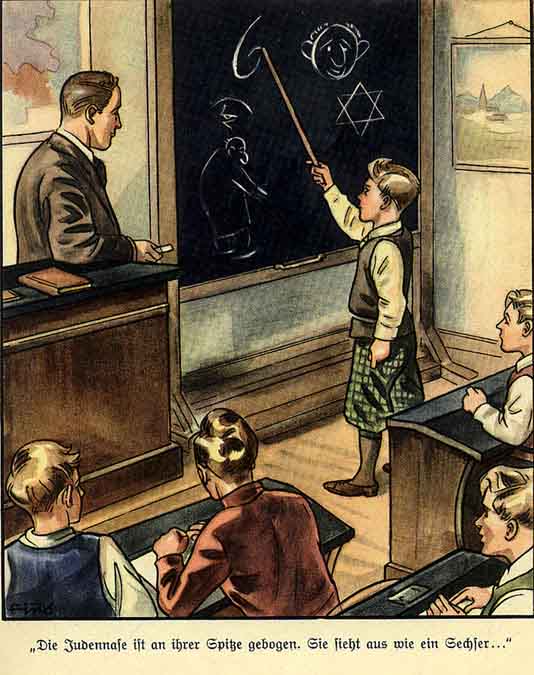
How To Tell A Jew
Things are lively in Mr. Birkmann’s 7th grade boys' class today. The teacher is talking about the Jews. Mr. Birkmann has drawn pictures of Jews on the blackboard. The boys are fascinated. Even the laziest of them, “Emil the Snorer,” is paying attention, not sleeping, as he so often does during other subjects. Mr. Birkmann is a good teacher. All the children like him. They are happiest when he talks about the Jews. Mr. Birkmann can do that well. He learned about the Jews from life. He knows how to put it in gripping terms such that the favorite hour of the day is the “Jewish hour.” Mr. Birkmann looks at the clock.
It is almost noon,” he said, “now we want to summarize what we have learned in this lesson. What did we discuss?”
All children raise their hands. The teacher calls on Karl Scholz, a little boy on the first bench. “We talked about how to recognize a Jew.”
“Good! Now tell us about it!”
Little Karl takes the pointer, goes to the black board and points to the sketches.
“One usually recognizes a Jew by his nose. The Jewish nose is crooked at the end. It looks like the figure 6. Therefore it is called the “Jewish Six". Many non-Jews have crooked noses, too. But their noses are bent, not at the end but further up. Such a nose is called a hook nose or eagle’s beak. It has nothing to do with a Jewish nose.”
“Right!” says the teacher. “But the Jew is recognized not only by his nose …” The boy continues. The Jew is also recognized by his lips. His lips are usually thick. Often the lower lip hangs down. That is called “sloppy". And the Jew is also recognized by his eyes. His eyelids are usually thicker and more fleshy than ours. The look of the Jew is lurking and sharp.
The teacher calls on another lad. He is Fritz Müller, and is the best in the class. He goes to the board and says:
“Jews are usually small to mid-sized. They have short legs. Their arms are often very short too. Many Jews are bow-legged and flat-footed. They often have a low, slanting forehead, a receding forehead. Many criminals have such a receding forehead. The Jews are criminals too. Their hair is usually dark and often curly like a Negro's. Their ears are very large, and they look like the handles of a coffee cup.”
The teacher turns to the students.
“Pay attention, children. Why does Fritz always say 'many Jews have bow legs', or 'they often have receding foreheads,' or 'their hair is usually dark'?”
Heinrich Schmidt, a large, strong boy in the last row speaks.
“Every Jew does not have these characteristics. Some do not have a proper Jewish nose, but real Jewish ears. Some do not have flat feet, but real Jewish eyes. Some Jews cannot be recognized at first glance. There are even some Jews with blond hair. If we want to be sure to recognize Jews, we must look carefully. But when one looks carefully, one can always tell it is a Jew.”
“Very good,” the teacher says. “And now tell me about other ways to tell Jews from non-Jews. Richard, come up here!”
Richard Krause, a smiling blond lad, goes to the board. He says: “One can recognize a Jew from his movements and behavior. The Jew moves his head back and forth. His gait is shuffling and unsteady. The Jew moves his hands when he talks. He “jabbers.” His voice is often odd. He talks through his nose. Jews often have an unpleasant sweetish odor. If you have a good nose, you can smell the Jews.”
The teacher is satisfied.
“That how it is, kids. You have paid attention! If you pay attention outside school and keep your eyes open, you won’t be fooled by the Jews.”
Then the teacher goes to the desk and turns over the black board, on its back is a verse. The children recite it in chorus:
From a Jew’s countenance — the evil devil talks to us,
The devil, who in every land — is known as evil plague.
If we shall be free of the Jew — and again will be happy and glad,
Then the youth must struggle with us — to subdue the Jew devil.
